Aracari travel planner, Bronwen Griffith has recently returned from a bespoke travel experience in Bolivia. Here she shares stories, tips and ‘best bits’ from her tour. “Our journey began in Sucre, a city in the southern highlands of Bolivia. Colonial architecture, prettily whitewashed houses and looming towers with a Moorish influence greet you on arrival in this beautiful city”.
Sucre
Sucre shares capital city status with La Paz and boasts a wealth of history and culture. We couldn’t wait to dive into it.
Our first stop was Hotel Parador Santa Maria Real. It’s well located and extremely comfortable. The owner, Mr. Luis Rodriguez is often on hand to give you a tour or impart some of his extensive knowledge of Sucre. He also loves to proudly show Aracari guests his small museum collection.
One of the highlights of Sucre is La Recoleta, a colonial-era church and convent seated high on a hill. It offers spectacular panoramic views over the city. You can tour the church to learn more about its long history and discover what life is like for the people who still live and work there.
Another must-visit for Sucre is the Casa de Libertad (Freedom House). This is where the Bolivian declaration of independence was signed in 1825. You can view the Independence Act document and a handful of other important relics inside.”
Potosi
From Sucre, Bronwen and her friends moved on to Potosi; one of the highest cities in the world. Potosi is a UNESCO World Heritage Site and historic mining town, lying at the foot of the Cerro De Potosi Mountain. Potosi is home to the former Royal Mint, now an important museum, and the Cerro Rico mine.
“Our time in Potosi was short but we managed to pack a lot in. We started with a visit to the bustling Tarabuco Sunday market with its many colourful stalls. After lunch we headed to the Hotel Museo La Cayara, a charming family-owned Hacienda dating back to the 1500s.
The Mint is closed on Mondays, so plan your trip accordingly if you intend to visit. Instead, we toured the Cerro Rico mine. Cerro Rico was once the biggest silver mine in the world, turning Potosi into a bustling metropolis in the 16th Century.”
Uyuni
Uyuni is the largest salt flat in the world, it expands 10,582sq km at an altitude of 3,656m above sea level. There is so much to see and experience in Bolivia that it can be hard to choose but Uyuni is a must-visit, as Bronwen explains.
“Our route to Uyuni took us through breathtaking scenery and the Eduardo Avaroa National Reserve. We travelled through the Dali Desert, saw the Licancabur Volcano, drove past thermal baths and took in the famous Fumarolas 4850m above sea level. Our stop at Laguna Roja was a personal highlight. Here you will find hundreds of flamingos and very few people so it’s quite the experience.
On arrival at the salt flats I was overcome with emotion. Not often have I felt such an impact from the wonders of nature. The flats were far more breathtaking than I could have imagined.
The experiences on offer at the famous Bolivian salt flats are extensive and varied. As time was short, we had to pick and choose carefully. We decided to climb the first stage of the Thunupa volcano (5321m) to the Mirador de Tahua. But other experiences available include an excursion to the sacred grounds of Alkaya, a visit to quinoa fields, and an opportunity to meet llama farmers.”
La Paz
Bronwen’s final experience in Bolivia was La Paz, a city unique for its geographical setting. It is the highest capital city in the world, set in a canyon created by the Choqueyapu River. The city is watched over by the towering, triple peaked Illimani Mountain. It is a magnificent place, with much to see and do.
“La Paz is a diverse and exciting city. The political centre, sprawling indigenous street markets, and cosmopolitan areas are always bustling with locals and tourists alike. And there’s a well-maintained and reliable cable car network, which provides spectacular views.
Some of my favourite sites in La Paz included the Calle Jaen, Plaza Murillo, Palacio de Gobierno and MUSEF (a small ethnography and folklore museum). I also loved the Church of San Francisco and the mesmerizing witchcraft market.
My trip was the perfect introduction to Bolivia. There is so much history and culture, breathtaking nature and incredible food, that I was glad for an itinerary covering the very best bits. I would heartily recommend the Bolivia: Salt Flats and Silver tour to anyone unsure of where to travel in Bolivia.”
Contact us today to create your very own tailormade itinerary to Bolivia, or explore one of our many itineraries for inspiration! Also check out our information about the next fixed trip to Uyuni: Uyuni salt flats photography workshop at Kachi Lodge.














